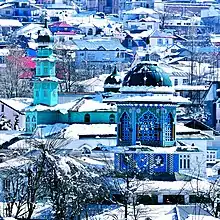Shah Farid-ud-Din Baghdadi
Shah Mohammed Farid-ud-Din Baghdadi (c. 1551 AD – c. 1733 AD), also known by the honorary title Shah Sahib, sometimes spelled as Fareed-ud-Din, was the seventeenth century's Iraqi Sufi saint. He is believed to had propagate Islam in Chenab Valley of Jammu and Kashmir. He left for Saudi Arabia and offered the Hajj at Mecca, and subsequently travelled through Egypt and Sindh. Prior to his propagation of Islam in the valley, he travelled through Agra and then reached to Kishtwar where he spread Islam around 1075 Hijri corresponding to 1664 AD.[1][2][3]He was 75 at that time.
Shah Farid-ud-Din Baghdadi | |
|---|---|
 Shrine (Ziyarat) of Shah Farid Ud Din Baghdadi Kishtwar in Winters. | |
| Born | Shah Mohammed Farid-ud-Din Baghdadi 1551 Iraq |
| Died | 1733 (aged 181–182) Kishtwar, Jammu and Kashmir |
| Major shrine | Kishtwar, Jammu and Kashmir |
Tradition or genre | Rishi |
Biography
He was born to a descendant of Sheikh Abdul Qadir Jilani, Syed Mustafa. He had two sons Shah Asrar-ud-Fin and Shah Akhyar-ud-Din.
Farid-ud-Din travelled across multiple regions of the valley, particularly Kishtwar. He reached there along with his followers and two sons, and introduced Sufism, a branch of Islam.[1][4] It is believed that Islam was already spread in the past by other Sufi saints and preachers, including Mir Sayyid Ali Hamadani, Nund Rishi and Zain-ul-Abedeen Rishi.[5]
Before his arrival in the valley along with Dervish Muhammad, Yar Muhammad, Syed Baha Uddin Sa’ani and Shah Abdal, he visited Agra near Shah Jehan’s reign at the age of seventy-five.[1]
After the religion was spread in the area, the ruler of Kishtwar, Raja Kirat Singh, is believed to have accepted Islam under the influence of the saint and thus the ruler became known by his Muslim name, Raja Tegh Muhammad Singh.[6]
Death and legacy
Farid-ud-Din died in 1733 AD in Kishtwar area where a dargah was constructed by the local people or by state government. His Urs (death anniversary) is celebrated annually by Kashmiri people between 19 to 20 June. Nearly 50,000 devotees attend Ziyarat complex (shrine of saint) in the region. The shrine authorities display the saint's sword, cloths and stick he used throughout his life.[7][8] He is buried next to his son in a tomb which stands in the center of town.[1]
References
- "Urs Shah Farid-ud-din Sahib | District Kishtwar, Government of Jammu & Kashmir | India".
- Chowdhary, Rekha (17 August 2013). "Kishtwar's past has the answer to its future" – via www.thehindu.com.
- Vijay, Madhuri (15 January 2019). The Far Field. Grove Press. ISBN 9780802146373 – via Google Books.
- Tremblay, Reeta Chowdhari; Bhatia, Mohita (25 May 2020). Religion and Politics in Jammu and Kashmir. Taylor & Francis. ISBN 9781000078794 – via Google Books.
- "Urs Hazrat Shah Asrar-ud-Din observed with traditional religious fervor - Early Times Newspaper Jammu Kashmir". www.earlytimes.in.
- "TBI Specials: A Different Kishtwar - One Which Showed The Way In Religious Tolerance And Communal Harmony". 21 August 2013.
- "Urs Of 17th Century Sufi Saint Celebrated With Religious Fervor in Kishtwar". 20 June 2013.
- "Thousands participate in Urs Shah Fariduddin (RA) at Kishtwar". Greater Kashmir. 21 June 2016.